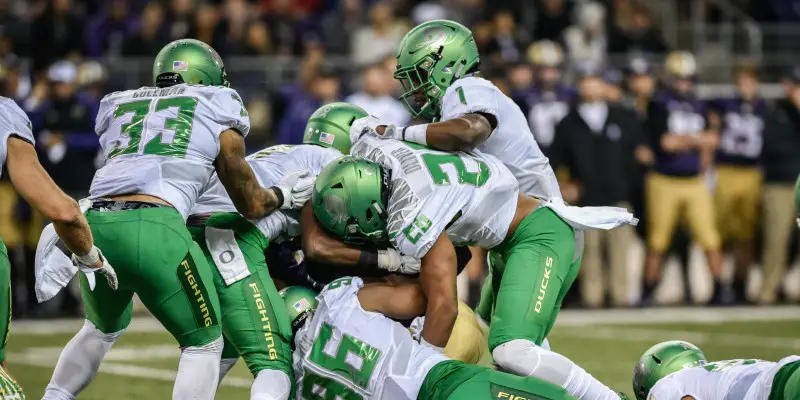Last week I investigated the Oregon defense by comparing key metrics over the past 10 years. In doing so, I was able to discover how the Ducks have evolved on the defensive side of the ball. By establishing a baseline comparison to past performance I can now confidently compare the 2015 defense to other Oregon teams.
Because team offense has an implicit effect on team defense, it is befitting to compare the Oregon defense to defense on teams that run a similar spread offense. Coincidentally, this is an excellent opportunity to evaluate the Ducks’ upcoming Alamo Bowl opponent, the TCU Horned Frogs.
TCU has been running a spread offense since Dutch Meyer invented his “Meyer Spread” offense in the 1930s. Dutch wrote the book on spread offenses. Literally. In 1952, he authored the book “Spread Formations in Football,” detailing his innovative offense. During his tenure as head coach from 1934-1953, coach Meyer amassed 109 wins, good enough for a school record which stood for 59 years until Gary Patterson surpassed it in 2012.
Patterson has had much success with the spread, as well. From 2009-2011, TCU had a record of 36-3. In 2014, after two consecutive down seasons, Patterson brought in offensive coaches Doug Meacham and Sonny Cumbie to install the air-raid variant of the spread. But one thing has remained constant in Fort Worth: a dominant Horned Frog defense. TCU has led the nation in total defense four times during Patterson’s tenure.
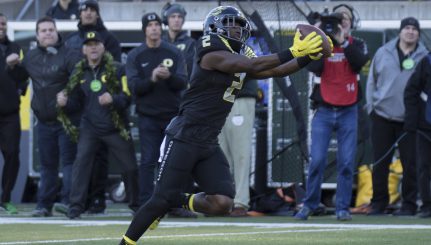
Bralon Addison catches a touchdown against USC.
The similarities on offense are striking for Oregon and TCU. Both have the ability to score, and score a lot. What is not entirely clear is how these two teams compare on the defensive side of the ball.
Patterson and his Frogs are often recognized for their vaunted 4-2-5 defense, which has excelled over the years. Oregon on the other hand is often criticized for being soft by allowing their opponents to score in volumes and convert third downs at will. So let’s start by looking at how these two teams compare over the past 10 years in third-down conversions allowed.
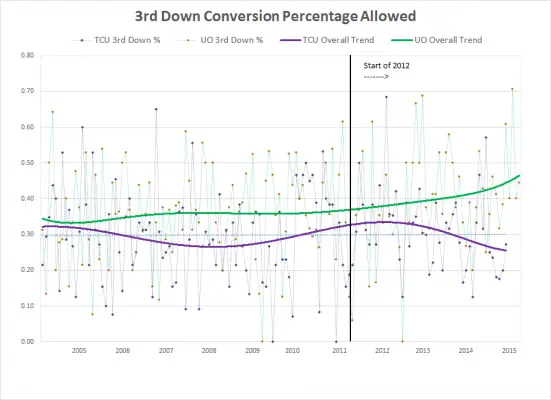
In 2005, both teams were strong in this category. TCU allowed a third-down conversion rate of only 31%, and Oregon allowed an average of 34.09%. Beyond 2005 this similarity diverges. That is until the 2012 season, when TCU became a member of the Big-12 conference.
Upon entering their new conference the Horned Frogs experienced a slight regression before improving from 2013 and beyond. In 2014 TCU ranked 2nd in the nation for third-down conversion defense. Oregon ranked 89th in the same category.
This season, the Frogs rank 7th, while the Ducks rank 103rd This will obviously be a point of emphasis in the upcoming Alamo Bowl matchup. Our high-flying Duck offense will need to stay on the field on third down against a stout defense, and our defense will need to find a way to get TCU off the field occasionally on third down. Whoever comes out ahead on third down has a great chance of also coming out ahead on the scoreboard.
Beyond third-down conversion percentages, fans in Eugene and alumni around the world are shaken by the amount of points the Ducks have allowed in 2015. But look no further than our Alamo Bowl opponent to find another team which has allowed an increasing amount of points.
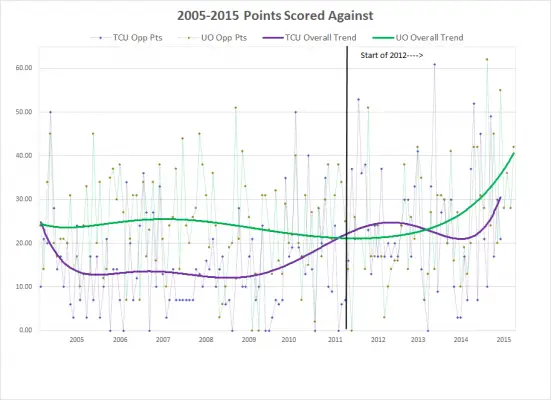
Since joining the Big-12 TCU has allowed a significantly increased number of points. From 2005 through 2011 it allowed an average of only 14.66 points per game. Since the 2012 season the Horned Frogs’ points allowed per game has been on the rise. In 2015, it took a sharp upward trend, similar to the Oregon defense.
Another defensive similarity is observed by examining the evolution of defensive efficiency in the red zone. The mighty men in green have consistently been more porous in the red zone than the Horned Frogs, but the overall trend for both teams is surprisingly similar.
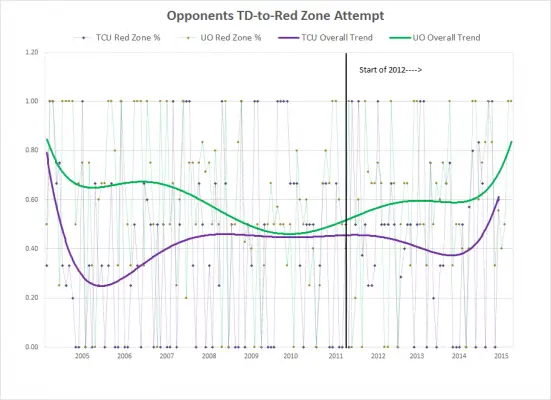
This trend follows an inverted u-shaped path with dramatic upward turns in the 2015 season. In 2015, the Frogs allowed opponents to score a touchdown on 50% of their red zone attempts, a higher average than any season in the past 10 years (the 2005 average was 49%). In comparison, the Ducks allowed a touchdown on 73.38% of opponent red zone attempts this season, greater than all but the 2005 season.
One area where our beloved Ducks have a historical advantage over TCU is in turnover margin. Oregon has traditionally excelled in this category and has outperformed TCU in recent years. The Frogs were also strong in this category — until joining the Big-12. Since shifting conference allegiances, TCU has seen a decline in its ability to both force turnovers and protect the football.
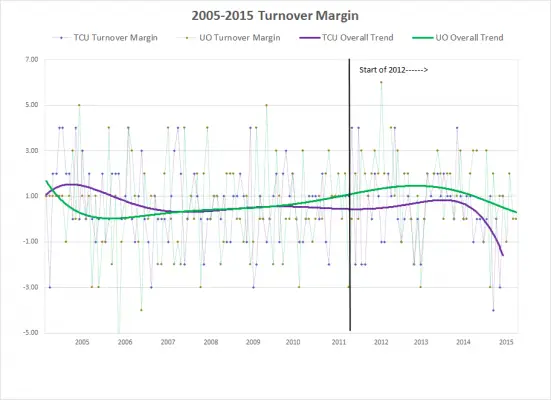
Frankly, the Horned Frogs have fallen off a cliff in turnover margin this season. While the Ducks have experienced a modest decline, they remain strong in this category, ranking 33rd nationally compared to TCU’s 65th. This should be a point of strength for Oregon, and could offset its inability to get off the field against a powerful Horned Frog offense.
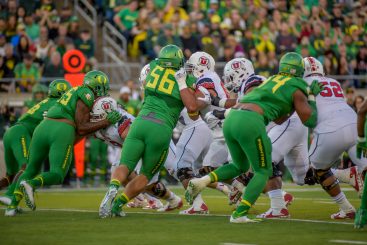
The Oregon Defensive line attacking.
That being said, the biggest defensive edge for the Ducks lies at the point of attack. This team has excelled at accumulating sacks and tackles for a loss. By forcing 80 tackles for a loss, the Ducks have a comfortable edge over TCU. With 36 sacks this season, Oregon averaged 3 sacks per game. This is good for 10th in nation, while the Frogs are ranked 43rd.
Much has been made about the similarities on offense between these two teams. But looking at the overall defensive trends we can see that the similarities extend to the “other” side of the ball as well.
While TCU has long been known for its stout defensive units, this analysis shows that the 2016 Alamo Bowl will by no means be a lopsided contest on either side of the ball.
Top Photo by Kevin Cline
Evan is a native Oregonian who grew up in the historic town of Oakland, once known as the Turkey capital of America. Evan attended the University of Oregon and is a Lundquist College of Business alumnus, and he has a Masters in Statistics and a PhD in Natural Resource Economics from University of Tennessee
While at Oregon he attended nearly every home football game and fostered his love for all things Oregon Duck. He now works for Ernst & Young amid the Huskies in downtown Seattle, and loves using his skills to study his beloved Ducks.

